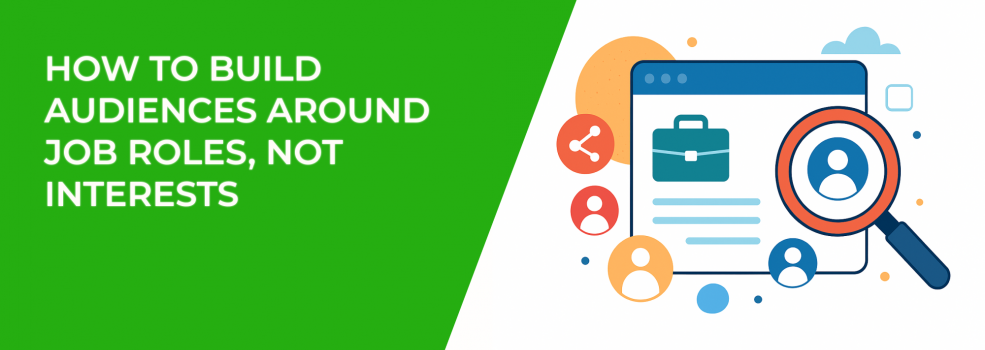Many advertisers stick to interest-based targeting on Facebook. It’s quick and familiar. But if you’re trying to reach professionals or decision-makers, interests alone don’t always work.
Someone who “likes” marketing pages may just be curious. Someone with the job title Marketing Manager makes real budget decisions. That’s a big difference.
This is why job-role targeting matters.
Why Job Roles Beat Interests
Interests show what people follow. Job roles show what people actually do every day. That’s why role-based targeting often performs better. It helps you:
-
Reach decision-makers;
-
Cut wasted impressions;
-
Generate higher-quality leads.
Example: Suppose you want to reach project managers. Instead of only typing “Project Manager” into Facebook’s detailed targeting, you can use LeadEnforce to find groups like “Certified Project Managers Network,” or pages such as “PMI – Project Management Institute.” By targeting followers of those groups, you reach professionals who are actively engaged in their field, not just people casually interested.
If you’re curious how Facebook targeting is changing overall, check out Facebook Ads Targeting Updates: How To Adapt in 2025.
Start with Job Titles
Facebook lets you target by job title. Think of roles such as:
-
Marketing Manager;
-
Software Engineer;
-
HR Specialist.
This is a good place to start. But remember: not every job title is included, and not everyone updates their profile.
Tip: Test variations. Instead of only targeting “Project Manager,” also include:
-
Program Manager;
-
Product Manager;
-
Operations Manager.
Keep each group in separate ad sets. You’ll quickly see which titles convert and which ones waste clicks.
For more tips on precision targeting, see How to Use Facebook Detailed Targeting to Reach Micro-Niche Audiences.
Add Seniority Levels
Job titles don’t tell the whole story. A manager and a director have different influence.
Layer seniority with your job roles. For example:
-
Managers may research tools;
-
Directors may lead buying decisions;
-
Executives may sign off budgets.
Mixing roles and seniority helps you cover all decision-makers without losing focus. If you’re not sure how to combine different audience layers, read How to Layer Detailed Targeting for Hyper-Specific Facebook Audiences.
Target by Industry or Employer
Context matters. An HR Manager in healthcare has different needs than one in tech.
You can refine your audience by combining roles with industries. For example:
-
Healthcare;
-
Technology;
-
Education;
-
Manufacturing.
This gives you smaller, sharper groups. It also lets you adjust your ad creative for each industry’s challenges.
Want more precision? This is where tools like LeadEnforce help. You can target people who follow Facebook groups and pages tied to specific job titles.
For example, say you’re promoting HR software for hospitals. You could target followers of pages like “Healthcare HR Professionals,” or groups where hospital staff discuss staffing challenges. Learn the workflow in How to Build Your Target Audience from a Facebook Group.
Build Lookalikes from LinkedIn Leads
LinkedIn has stronger job data than Facebook. But ads there can be expensive.
Here’s a workaround:
-
Collect LinkedIn leads with job-role data;
-
Upload them into Facebook as a custom audience;
-
Create lookalike audiences.
Now, Facebook finds people with similar professional traits, even if their job titles aren’t listed.
If you want a deeper dive, check Custom vs Lookalike Audiences: What Works Best for Facebook Campaigns?.
Use Exclusions Wisely
Exclusions are just as important as inclusions. They stop your ads from reaching the wrong people.
Think about who you don’t want to target. For example:
-
Entry-level roles, if you’re selling enterprise software;
-
Unrelated industries, that don’t need your solution;
-
Job functions, outside your buyer group.
Exclusions protect your budget and sharpen your results.
Learn more in When to Use Exclude Targeting on Facebook and Why It Matters.
Match Creative to the Role
Targeting is only half the job. The other half is your ad message.
-
Managers want tools that save time for their teams;
-
Executives want to see ROI and growth potential;
-
Technical staff want features, integrations, and details.
Don’t use the same creative for everyone. Split your audiences and tailor the message to each role.
For inspiration, read The Psychology of Facebook Ads: How to Hook Your Target Audience in Seconds.
Final Thoughts
Targeting by job roles takes more effort than picking a few interests. But it brings you closer to the people who can actually buy or influence the decision.
Remember to:
-
Test multiple job titles;
-
Layer seniority and industry;
-
Use exclusions;
-
Align creative with role.
When you shift from interest-based targeting to role-based targeting, you stop chasing clicks and start connecting with real decision-makers.

